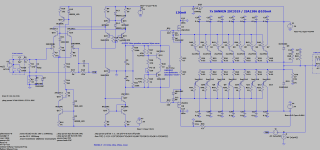Hi Thimios,
You could use 5 x MUR120 in series
If you bond them to the heatsink.
The Thermalraks use that diode but embedded in the body of the transistor.
- Dan
You could use 5 x MUR120 in series
If you bond them to the heatsink.
The Thermalraks use that diode but embedded in the body of the transistor.
- Dan
Thanks daniel,i know about Thermalraks but i have so many Power bjt on hand.
Thermalraks are expensive,100euro for 12 pieces!😡
Thermalraks are expensive,100euro for 12 pieces!😡
Yes the price has gone up recently.....
I built an RMI-FC100 and it is a really nice design.
You could use regular diodes in a string but the MUR120 is what is inside the thermal track package. And you can get them separately.
I built an RMI-FC100 and it is a really nice design.
You could use regular diodes in a string but the MUR120 is what is inside the thermal track package. And you can get them separately.
Thanks again!
I have some remaining Rudi's pcb.
Recently i received some 2sk170 jfet.(original Toshiba).
I hope ksa1381,c3503 are suitable here too(instead 3423,1360)
This willbe a future project..
I have some remaining Rudi's pcb.
Recently i received some 2sk170 jfet.(original Toshiba).
I hope ksa1381,c3503 are suitable here too(instead 3423,1360)
This willbe a future project..
I think so since the rails are quite low, but I would double check the datasheet.
It is a nice amp
- Dan
It is a nice amp
- Dan
Very nice!
I used the LT3045 regulated one but the shunt is the original.
Good luck with the build if you end up building one, mine has been very reliable over the last few years.
- Dan
I used the LT3045 regulated one but the shunt is the original.
Good luck with the build if you end up building one, mine has been very reliable over the last few years.
- Dan
I am sorry Thimios, I have asked myself the same question......
It is a never ending story. 🙂
It is a never ending story. 🙂
Hi Thimios,How can i convert the circuit adding a Vbe multiplier,so i could use BJT like njw0281,0302 as output?
FC100 is also on my todo list some day. Below on example of how the VBE multiplier could be. This design is fine tuned and very very stable, for the output stage seen here.
Attachments
Don’t look to much to the output stage, just wanted to give ideas for VBE multiplier. (I have this output stage running in my monoblocks and had the idea to put the FC100 front stage to it)
It is rather easy to replace those obsolete Toshiba Fet’s with laterals.
It is rather easy to replace those obsolete Toshiba Fet’s with laterals.
I have the output transistor with quite Ve differences, the 0281 are 17,30-19-15,84mV the 0302 are 12,95-28,03-11,41mV. All voltages are right until the diode string where I have 2,36V and I across R5 is only 72mA. Those readings are after I substitued Q19, Q20, Q1, Q3 because unfotunately the MJE at first power on weren't isolated from the heatsink. Could this have damaged the TT too?
Greetings all! It's been a long time since I visited this forum, so I hope this isn't considered poor etiquette. But is anyone interested in an almost complete set of parts to build this amp? When this thread first started, I followed it closely and purchased all of the parts (PCB's, several sample ThermalTraks for future matching, matched inputs (J1 & J2), most the rest of the components, heatsinks, toroidal transformers - basically everything but the enclosure and a couple of the other matched transistor sets. For the longest time I held out hope that I would get to complete the build, but, alas, that phase of life has passed. I regret not having the opportunity to hear this design in action, but I would be happy knowing someone else could put the parts I collected to use. If this is not the appropriate place for this, please let me know.
Thanks,
Ted
Thanks,
Ted
Last edited:
Hi vizion,
The actual output power of any amplifier is dependant on the supply voltage, and your AC mains more than anything else. That's assuming a decent design and protection that isn't overzealous. So if your internal supply drops a lot with current, or your AC outlet voltage drops under load, the amplifier will not deliver full power. There is always some supply droop.
Also, a few watts doesn't mean anything. If it does you are either running sine wave output for an industrial application, or you are very probably clipping. Dynamic music has a 1:10 to 1:15 average to peak ratio. There isn't much real difference between a 60 watt amplifier and a 70 watt amplifier.
-Chris
The actual output power of any amplifier is dependant on the supply voltage, and your AC mains more than anything else. That's assuming a decent design and protection that isn't overzealous. So if your internal supply drops a lot with current, or your AC outlet voltage drops under load, the amplifier will not deliver full power. There is always some supply droop.
Also, a few watts doesn't mean anything. If it does you are either running sine wave output for an industrial application, or you are very probably clipping. Dynamic music has a 1:10 to 1:15 average to peak ratio. There isn't much real difference between a 60 watt amplifier and a 70 watt amplifier.
-Chris
RMI-FC100 specs:hello, I understand the amp runs in 2w class A. What is the output in Class aB ? Thanks.
Class A power: 2W rms into 8ohm with Iq=0.6A (maximum Iq for optimal B class bias)
Class B power: 90W rms into 8ohm
OLG: 94dB
CLG: 1:40 (32dB)
SR: +/-75V/us
Phase margin > 67grd
Frequency response: DC to 210KHz (-1dB)
- Home
- Amplifiers
- Solid State
- RMI-FC100, a single stage audio power amplifier

